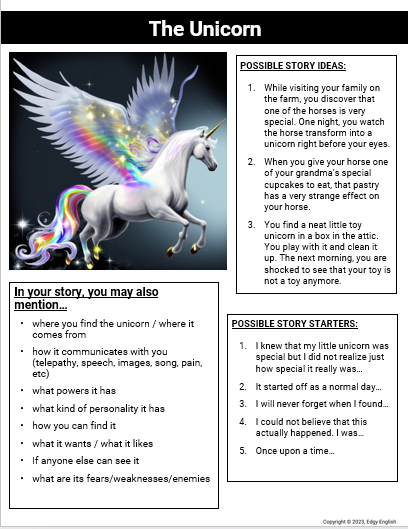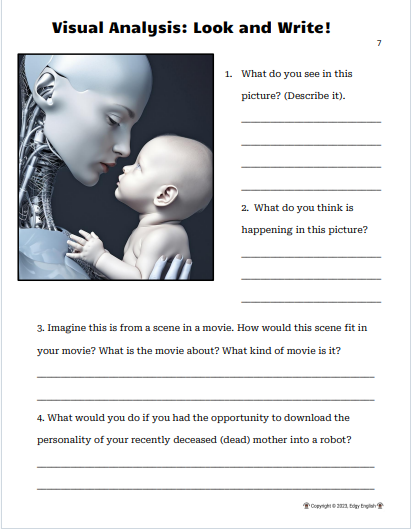15 Reasons Why Teachers Should Use Picture Prompts in Class
Picture prompts can be a valuable tool in an ESL classroom, particularly in a context where students are familiar with visual technology such as cell phones, social media, and video games. There are 15 reasons why teachers should use picture prompts:
Visual Engagement
Language Association
Contextural Understanding
Cultural Education
Promotion of Critical Thinking
Stimulate Creativity
Versatility
Appreciation of Visual Media
Aiding Special Needs Students
Inclusive Learning
Promotion of Discussion
Memory Enhancement
Real-World Relevance
Lower Pressure
Non-Verbal Communication
1. Visual Engagement:
Students, particularly those growing up in the digital age where visuals are prevalent, respond positively to visual stimulation. In an educational context, pictures can draw students in and hold their attention far more effectively than text alone. For instance, a picture depicting a vibrant cityscape can instantly capture students' interest and curiosity, encouraging them to engage with the lesson. This engagement not only keeps students attentive but also fosters an enjoyable learning environment. Considering the current generation's exposure to visually rich content through video games and social media platforms like Instagram and TikTok, picture prompts can offer a teaching method that is both familiar and appealing to them.
2. Language Association:
Pictures are a potent tool for teaching vocabulary as they offer a visual representation of the words, aiding in memory and comprehension. For example, when teaching students the word "frustration," a picture prompt depicting a person struggling to open a jar effectively communicates the concept. This visual association facilitates a more profound understanding of the word than merely providing a textual definition. With the proliferation of emoticons and memes on social media platforms, students are already accustomed to associating images with certain feelings or ideas. Leveraging this trend in the classroom can make vocabulary learning more efficient and relatable.
3. Contextual Understanding:
Pictures can provide context for new words and phrases, demonstrating how they're used in real-life situations. For example, if you're teaching the phrase "pitching a tent," a picture showing people setting up a tent in a campground can help students understand the phrase in a practical context. Such a strategy is particularly beneficial for ESL students as it goes beyond dictionary definitions, demonstrating words and phrases as they naturally occur in the language. This context-based learning can be compared to video game tutorials where players learn the game controls not in isolation, but within the context of the gameplay.
4. Cultural Education:
A picture is worth a thousand words; it can provide insights into various cultures, their traditions, lifestyles, and more. When teaching ESL, it's essential to acquaint students with the culture of the language to foster a holistic understanding. Showing a picture of a Thanksgiving dinner table, for instance, can serve as a springboard for discussing the American holiday, its historical roots, and the customs associated with it. Similarly, images from popular media, such as scenes from Hollywood films or iconic video game characters, can be used to discuss cultural nuances and stereotypes, providing a well-rounded cultural education.
5. Promotion of Critical Thinking:
Pictures can encourage students to analyze, interpret, and infer, thereby promoting critical thinking. For example, showing a picture of a crowded subway and asking students to describe what they see, feel, or deduce from the image can provoke thoughtful discussions. This kind of activity engages students on a deeper level, pushing them to think critically and use the language skills they're learning. Much like interpreting the storyline or character motivations in a video game or social media post, this practice helps students make connections and view the language from various perspectives.
6. Stimulate Creativity:
Picture prompts can be a catalyst for creativity in the classroom. By looking at a picture, students can create their own stories or descriptions, effectively exercising their imagination. For instance, given a picture of an empty park bench, students could craft a story about who might have been sitting there and why it's empty now. This creative exercise resembles creating narratives for characters in video games or coming up with captions for Instagram posts – activities that many students likely engage in during their free time.
7. Versatility:
One of the significant advantages of picture prompts is their versatility. They can be used to teach vocabulary, facilitate discussions, inspire creative writing, teach grammar in context, and much more. For example, a picture of a bustling marketplace can be used to teach descriptive vocabulary (crowded, lively, noisy), prepositions (beside the fruit stall, on top of the counter), and verbs (haggling, selling, buying). Teachers can adapt the usage of pictures based on the lesson plan and students' proficiency levels, offering a customizable teaching tool.
8. Appreciation of Visual Media:
Today's students are growing up with a profound appreciation for visual media. Video games, social media platforms, and streaming services have made images and videos an integral part of their daily lives. By incorporating picture prompts in the classroom, teachers can tap into this familiarity and appreciation. For instance, using images from popular video games to teach English can pique students' interest and make the lessons more relatable. It's like bringing a piece of their world into the classroom, which can significantly enhance their learning experience.
9. Aiding Special Needs Students:
Picture prompts are an effective tool for special education students, especially those who have difficulty processing large amounts of text. Visuals can simplify complex ideas and provide an alternative way of understanding the lesson. For example, a student with dyslexia might struggle with a lengthy text describing a forest. But a picture of a forest can convey the same information more easily and quickly, eliminating the frustration that might otherwise occur.
10. Inclusive Learning:
Picture prompts can help foster an inclusive learning environment. Students who struggle with traditional text-based learning, such as those with dyslexia or attention deficit disorders, often find it easier to process visual information. By using picture prompts, teachers can ensure that all students, regardless of their learning style or ability, can participate in the lesson and have an equal opportunity to learn. Furthermore, picture prompts can be more universally understood, regardless of a student's language proficiency level, providing a more equitable learning experience.
11. Promotion of Discussion:
Pictures can ignite discussion in the classroom. A thought-provoking image can lead to students sharing their interpretations, opinions, and feelings, promoting conversational practice in the target language. For example, an image depicting a controversial topic like climate change can trigger a lively discussion. This practice gives students a safe and structured environment to voice their opinions and learn to articulate their thoughts in English, mirroring the interactive discussion that occurs on social media platforms.
12. Memory Enhancement:
Visuals can significantly enhance memory recall. When we see an image, we don't just remember the picture; we remember the emotions, thoughts, and ideas associated with it. Therefore, using picture prompts can make language learning more memorable. For instance, after seeing a picture of a boy holding a melting ice cream under the scorching sun, students might find it easier to remember words and phrases associated with hot weather. This strategy is similar to how memorable scenes in video games or popular social media posts stick in our minds.
13. Real-world Relevance:
Images often reflect real-world situations, making them an effective tool for teaching language in a practical context. For instance, a picture of people waiting at a bus stop can introduce vocabulary related to public transportation and everyday conversation starters, helping students prepare for real-life English usage. By seeing language used in contexts that mirror their own lives or the media they consume, students can see the relevance of what they're learning, making the learning process more engaging and meaningful.
14. Lower Pressure:
Visual prompts can be less intimidating than text for beginner language learners. When presented with a complex text, beginners may feel overwhelmed. In contrast, discussing a picture provides a more accessible way to practice language skills. It reduces the pressure to understand everything at once, allowing students to focus on specific elements they're comfortable with. Just as a newcomer to video gaming might start with easier games, beginning ESL students can find picture prompts a manageable starting point.
15. Non-Verbal Communication:
Finally, pictures can be used to teach non-verbal communication and body language, important aspects of language often overlooked in traditional language instruction. For example, a picture of a person rolling their eyes can be a great way to introduce the concept of sarcasm or frustration. Similarly, pictures of people from different cultures greeting each other can be used to discuss cultural differences in non-verbal communication. Given that a significant part of communication on social media platforms and video games is non-verbal (through emojis, GIFs, avatars, etc.), understanding these elements in real-life scenarios can provide valuable skills for ESL students.
In summary, picture prompts serve as a versatile, engaging, and inclusive tool that caters to different learning styles and levels, aligns with the digital age's visual nature, and provides a comprehensive approach to language learning. By integrating picture prompts into ESL teaching strategies, educators can create dynamic and interactive classrooms that resonate with contemporary students' experiences and interests.
The problem is that it is difficult to find the perfect picture prompts that will inspire and grab the attention of the students. Fear not, I have provided a few examples of picture prompts to help. If you are interested in previewing or purchasing any of the following picture prompts, you will be redirected to my Teachers Pay Teachers store.















